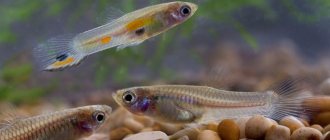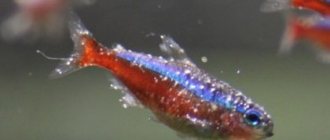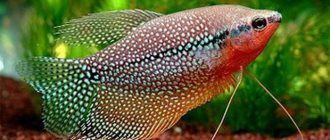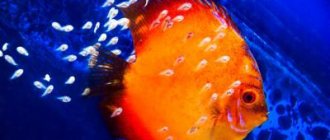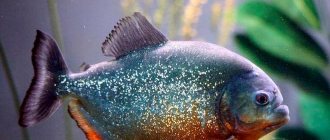General compatibility table for fish in one aquarium
To choose the right inhabitants for an aquarium, you need to know exactly which breeds can get along with each other. If you plan to keep crayfish, shrimp or other unusual inhabitants, their characteristics must also be taken into account.
Find out the compatibility of the aquarium fish you are interested in at the intersection of the names in the table. With full compatibility between cohabitants, clashes are excluded. Limited compatibility indicates the need of neighbors for a voluminous aquarium with shelters. Residents with conditional compatibility require supervision. Do not place completely incompatible fish in the same container.
Compatibility of fish in an aquarium
Now let’s take a closer look at each type of fish for compatibility. Below are descriptions of the main breeds and their compatibility with others. The author of the video will tell you how to choose the right ones for your home aquarium.
Ankara
The fish is generally peaceful and can be kept with other species. But it is important to remember that she is primarily a predator, so any fish that can fit into her mouth will be perceived primarily as food. Also dangerous for plants. They can be kept in flocks or alone.
Ancistrus
Ancistrus can be dangerous for large, slow-moving fish that lack scales. Crawling over a large object, without any malicious intent, catfish can damage the skin of fish. Lives alone. Sometimes Ancistrus competes with bottom dwellers for territory.
Apistogram
Even small, peaceful fish and even livebearers are favorably treated. Aggressive during spawning. Moreover, they treat aquarium plants favorably - they do not pinch, dig or uproot them. It settles alone or in a group of a male and 2–3 females.
Astronotus
Astronotus are very aggressive fish. Do not place with small fish, such as guppies and neons. Astronotuses perceive them exclusively as food. Plants are destroyed. Moreover, they exhibit intraspecific aggression. Content alone or in a group.
Barbus
In general, peaceful barbs in certain circumstances show their harmful and aggressive character. A gregarious and active species.
Do not keep more than 6 barbs in the aquarium. The fish will either sort things out among themselves, or in a united flock they will begin to poison the rest of the pets. If the flock of barbs is quite small, the aggression of the species will also be great.
Bocia
Neighbors for fighting must be chosen with care. Compatible in an aquarium with peaceful fish of comparable sizes. These are very noisy fish. They bite the fins.
Guppy
Active and friendly appearance. Guppies are compatible with small fish of similar temperament. Keeping in a school or solitary.
Gourami
They have an easy-going, calm character and small size, with virtually no conflicts. Gouramis live alone, in pairs or in groups. They eat plants.
Danio
This species has a peaceful nature and has virtually no problems living together with other aquarium fish. School look.
Discus
These are slow and peaceful fish. Compatible with non-aggressive large fish.
gold fish
These are quite large fish. Compatible with peaceful cohabitants. Digs up plants.
Cardinal
Peacefully swimming fish. Gets along with neighbors of similar size and character. Schooling fish, from 10 individuals in a school.
Carnegiella
They get along well with peaceful and medium-sized fish. Lives in a flock of 6 individuals, prefers proximity to related species.
Koi carp
Get along with other koi and goldfish.
Congo
Peaceful, non-aggressive fish. Compatibility with peaceful and medium-sized water inhabitants. Pack living.
Labeo
Leads a solitary lifestyle. Clashes with others occur when there is not enough space.
Lyalius
Fish with a quiet disposition. It is unacceptable to keep with fish that bite off fins. Gets along with fish that have the same quiet disposition and similar habitat requirements.
Macropod
It is best to keep the macropod alone or with large and non-aggressive species.
Melanochromis
A very aggressive fish. Dangerous for plants and small fish.
Swordtails
Active, peaceful. Compatible with non-aggressive neighbors of similar size. Accommodation alone or in a group.
Mollies
Peaceful, very hardy and unpretentious fish. Compatible with aquarium pets of the same temperament.
Neon
Neons are schooling, calm and peace-loving fish; only during the mating season can they be nervous and extremely active.
Nothobranchus
Clashes occur between males. Place at least two females per male.
Paku
The fish are not aggressive. They live in groups and alone. Damage plants.
Ornathus
It is best kept with peaceful fish of approximately the same size as the ornathus.
Cockerel
Compatible with non-aggressive species of similar size. Keeping solitary or in a group of a male and several females.
Pecilia
Peaceful livebearer. Compatible with many types. They live in a flock together with other livebearers, but can also live alone.
Piranha
Suitable for single living. Intolerant of other species and neighbors.
Parrot
Peaceful and unpretentious fish. Compatibility with the same leisurely and non-aggressive creatures.
Pristella
Pristella gets along well with neighboring fish that are similar in size and temperament.
Pseudotropheus
Fish of the genus Pseudotropheus have an extremely uncooperative character. They react aggressively to blue and yellow colors in other fish.
Rainbow
Active and peaceful, compatible with fish of similar temperament and size. Living in a flock of 6 or more rainbows.
Rasbory
Friendly small fish successfully coexist with comparable species. They live in flocks of 8 individuals.
Splashfish
In nature, splashers live in schools, and in an aquarium you need to keep at least 4 of them, and preferably more. Dangerous for too small neighbors.
Angelfish
A leisurely and peaceful cichlid. Compatible with non-conflict indifferent fish. There should be at least 4 angelfish in one aquarium.
Catfish tarakatum
In fact, they do not pose any threat to other inhabitants of the aquarium. Aggression is possible during spawning.
Speckled catfish
Compatible with suitable sized aquarium fish species. Feels comfortable in a group of 3 or more individuals.
Ternetia
Most often, these fish show aggression towards smaller species. Incompatible with aquarium fish with long fins, they tend to tear them off and bite them.
Tetra
Tetras are only incompatible with cichlids, goldfish, and astronotus. They can be kept with other fish.
Tropheus
Tropheus are very aggressive inhabitants of aquariums. Single existence is allowed.
Philomena
Active and flocking neighbors. They will become a nuisance for slow and quiet neighbors.
Flashlight
The flashlight is an aquarium fish that is a representative of tetras, characterized by a peaceful and hardy character. This fish gets along well with other fish of the characin family, dwarf cichlids and catfish.
Chromis
Aggressive during the spawning period. They live in pairs. They bite plants.
Cichlazoma
Black-striped cichlasoma can get along well with non-aggressive fish. Its neighbors may even be small, peaceful species.
Classification of aquarium fish
To understand which varieties of aquarium fish are compatible, you should consider the parameters for classifying aquarium representatives.
By size:
- Large ones (Moorish idol, cichlids, surgeon fish) are considered long-lived. A novice aquarium owner should not rush to purchase them, as they are difficult to maintain. When defending their own nest, they are quite aggressive.
- Small fish are the most suitable option for beginners. The price of the fish is reasonable, and they are not fussy about keeping them. Small fish are more friendly.
By the nature of procreation:
- Egg-laying fish - beginners should wait a little while purchasing these individuals, because during spawning they require special conditions of detention.
- Viviparous - can breed in aquariums even in less than ideal conditions. This group of fish is unpretentious to temperature, as well as to the composition of water.
By location:
- Marine - to keep this type of fish, basic skill will be enough.
- Freshwater is a species of fish that looks no less interesting than marine species.
Compatibility Types
Varieties of fish among themselves can be:
- conditionally and absolutely incompatible;
- fully compatible.
The category of conditional compatibility includes aquarium fish species, the coexistence of which is impossible under certain conditions. Of course, it’s rare, but it happens that fish somehow manage to live together.
To make the selection task easier, you should use tables from specialized literature and the Internet .
Errors
- Incorrect arrangement. In addition to the temperament and size of the fish, consider the arrangement of the aquarium. For example, loaches burrow into the ground, so a sandy substrate is needed. Territorial species share the aquarium with thickets of plants. Unsociable and timid inhabitants of the waters are provided with subdued light and shaded areas.
- Overpopulation in the aquarium. There should be enough space for the fish to move freely. Clashes, rapid deterioration of water quality, and lack of oxygen are inevitable in an overcrowded aquarium.
- The composition and parameters of water are not taken into account. You can achieve complete similarity according to the fish compatibility table, but do not take into account the required parameters of the aquarium neighbors. Some fish may be similar in character to others, but the difference in water parameters will not allow them to live in the same aquarium. Incorrectly selected water parameters cause stress, reducing immunity.
- Population of fish of the same sex. Some species need to spawn for a comfortable existence. In cichlids, bettas and other species, males are aggressive towards each other.
- The type of food is not taken into account. Fish feed on the surface of the water, in the thickness or at the bottom, it depends on the structure. Bottom dwellers do not eat small flakes, and fish with an upper mouth will remain hungry if you throw sinking food into the aquarium.
- Inoculation of unsuitable plants. Some aquatic pets are prone to eating certain types of flora. Keep this in mind when landscaping your aquarium.
Feeding
Feeding characteristics are associated with the behavioral traits and nature of the life activity of catfish. They lead a bottom-dwelling lifestyle, feed on waste and rarely rise to the surface (with the exception of sucker catfish that move along glass).
But this does not mean that catfish do not need a feeder! Therefore, it is recommended to use heavy food that immediately sinks to the bottom. Live food is best: tubifex, bloodworms, frozen shrimp, plankton, and so on.
Compatibility Principles
- Keep big fish with big fish and small fish with small ones. The fish will not be eaten if they do not fit into the mouth of a large neighbor.
- Choose neighbors with similar temperaments. Playful fish are comfortable in the company of equally restless neighbors, but leisurely fish are annoyed by such roommates.
- The fish must come from places with a similar habitat. The permissible values of temperature, hardness, and acidity must be the same. Run two species with the same requirements, or one fancy species and another with a wide range of acceptable parameters. Consider the requirements for lighting, aquarium arrangement, water movement, and salinity.
How to populate incompatible species
Fish with different habitat requirements are not housed together. It is possible to introduce fish with different personalities. For a successful neighborhood, follow the rules:
- Choose a spacious aquarium. Create comfortable conditions.
- Place shelters. Divide the pond into territories using plants.
- Make sure there is enough food for everyone. Feed your fish quality food.
- Choose young individuals so that they get used to each other from a young age.
- Maintain the aquarium on time, change the water and siphon the soil.
Even full compliance with these rules does not guarantee that there will be no clashes between the inhabitants of the aquarium.
Limited compatibility
Not very good compatibility with Cichlid representatives:
- Types of cichlids with different temperaments. If you add Melanochromis Johan to the Auratus, then the probability of peaceful coexistence will be 50%.
- Small cichlids are sometimes compatible with small underwater inhabitants (swordtails, iris).
- Botsiya.
- Astronotus (with individual species of approximately equal size).
- Barbs (with equal sizes or with a slight difference).
All species of Cichlids have limited compatibility with other fish, provided that they grew up together from the age of fry or young fish. In this case, situations are known where even the most aggressive species coexist quite peacefully with neighbors that are unsuitable for them. But such settlement is possible only for young representatives. As adults, Cichlids become more aggressive and are suspicious of all strangers.
Adviсe
- There are species whose character changes as they grow older. For example, some catfish become territorial.
- Study the information yourself. The advice of others is not always correct. Find more information about your fish.
- The large number of fry and snails is regulated by the settlement of large neighbors.
Fish compatibility is a point that needs to be studied when becoming an aquarist. It is also important to know about fish nutrition, lighting, starting an aquarium and changing water parameters.
(Visited 3,016 times, 9 visits today)

